Congress officially passed a new, two-year transportation bill today. As I shared yesterday, it’s regarded by active transportation advocates as being downright bad. Even Portland Congressman Earl Blumenauer, who was on the conference committee that hashed out the final bill, calls its passage “strangely anti-climactic” (I spoke with Congressman Blumenauer today and will share his candid take on the bill in a separate story).
For their part, the Oregon Department of Transportation has wasted no time in parsing the numbers to see where their programs and funding levels stand with the new bill. ODOT’s role in doling out federal transportation funds has become heightened because a major theme of the new bill is that it gives more control of the pursestrings to states. For instance, a full one-half of the total amount of money in a new program dubbed “Transportation Alternatives” (about $307 million per year nationwide) will be doled out through a competitive grant program. (States can also decide to spend that chunk on other things, although given ODOT’s track record and trajectory of respect toward active transportation, it’s unlikely they would take part in that sneaky “opt-out” provision.)
Today ODOT released a document (PDF) showing how MAP-21 (the new bill) compares to SAFETEA-LU (the old bill, passed in 2005).
Overall ODOT expects the new bill to equate to a 7% decrease in total federal funding for transportation. Their total funding allotment from the feds in 2011 was $518.7 million and they expect MAP-21 will bring about $483.2 million to the state in 2013. You can see the breakdown of MAP-21 dollars in the chart below (which is split into the various new programs created in the new bill):
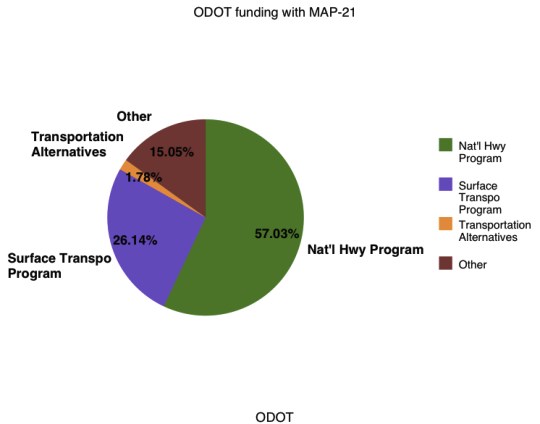
(Graphic: BikePortland)
ODOT says they’ll get $132.5 million from the Surface Transportation Program. Of that, Portland will receive $25 million.
In the existing transportation bill, three key programs for funding bicycle-related projects are Transportation Enhancements, Recreational Trails, and Safe Routes to School. Those three programs brought over $16 million to ODOT in 2011. In the new bill, those programs no longer exist on their own. Instead, they’ve been thrown into a soup and are merely considered a type of “eligible project” among many others in a program that will be called “Transportation Alternatives.”
According to ODOT calculations, that entire Transportation Alternatives pot will total just $8.9 million — or a mere 1.8% of the total federal transportation allotment. The way the new law is written, half of that must be dispersed by population (to be distributed by metropolitan planning organizations – ours is Metro), which means Portland will get $1.7 million a year. The other half (about $4.5 million) will be put into a statewide competitive grant program (which Portland will likely win a chunk of).
The Congestion Mitigation and Air Quality (CMAQ) program also took a hit in the new bill. Oregon got about $21 million from that program in 2011, but in 2013 ODOT expects CMAQ funds to total just $18.6 million. The big news for CMAQ is, not only is the total amount lower, but the new bill has added new types of projects into the eligibility pool. For example, Congress has decided that projects that add single-occupancy vehicle lanes and left turn lanes — both of which are not only expensive, but could not have used CMAQ funds at all in the past — can now compete for the money (and it remains unclear how adding lanes on highways does anything to mitigation air quality or congestion, but I digress).
Stay tuned for more coverage of MAP-21 and how it might impact Oregon and Portland.

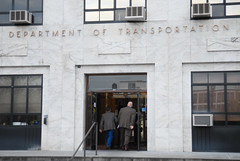

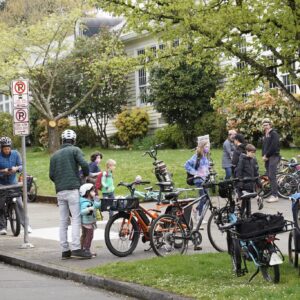
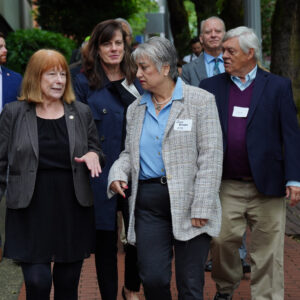
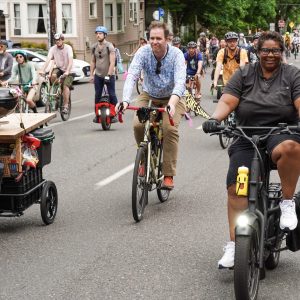
Thanks for reading.
BikePortland has served this community with independent community journalism since 2005. We rely on subscriptions from readers like you to survive. Your financial support is vital in keeping this valuable resource alive and well.
Please subscribe today to strengthen and expand our work.
The Feds (and most of the rest of our elected officials) have no overarching concept of how to deal with the real problems facing us, facing transportation, so they muck about and dig up old notions like how to spend a larger share of our tax dollars on highways.
It is at once exasperating and astonishing. Very nearly everything highlighted in this pie chart is premised on continued availability of cheap gasoline and diesel, and by cheap I also mean the absence of any consequences from burning it. This is a strange premise to take in 2012, when the International Energy Agency in its World Energy Outlook last November said that we had until 2015 to reverse the worldwide growth in fossil fuels (and specifically greenhouse gas emissions) if we hoped to barely avert climate catastrophe. I don’t see any acknowledgement of this fact (to name but one) in this bill.
I’m going to go out and ride my bike. I’m glad some of you have more patience and stamina to wade through the depressing minutiae of these bills.
http://www.worldenergyoutlook.org/docs/weo2011/pressrelease.pdf
“As each year passes without clear signals to drive investment in
clean energy, the “lock-in” of high-carbon infrastructure is making it
harder and more expensive to meet our energy security and climate
goals,” said Fatih Birol, IEA Chief Economist. The WEO presents a 450
Scenario, which traces an energy path consistent with meeting the
globally agreed goal of limiting the temperature rise to 2°C.
Four-fifths of the total energy-related CO2 emissions permitted to
2035 in the 450 Scenario are already locked-in by existing capital
stock, including power stations, buildings and factories. Without
further action by 2017, the energy-related infrastructure then in
place would generate all the CO2 emissions allowed in the 450 Scenario
up to 2035.”
http://www.guardian.co.uk/environment/2011/nov/09/fossil-fuel-infrastructure-climate-change?newsfeed=true
“The world is likely to build so many new fossil-fuelled power stations, energy-guzzling factories and inefficient buildings in the next five years that it will become impossible to hold global warming to safe levels, and the last chance of combating dangerous climate change will be “lost for ever”, according to the most thorough analysis yet of world energy infrastructure.
Hurricanes wash over the Gulf Coast destroying everything below flod stage and yet people keep returning to build below it.
Tornadoes wipe whole towns from the face of the earth leaving only sturdy buildings and people repeatedtly rebuild the weakest structure they can even when an equivalent cost will a nearly identical building of much increased survivability.
Low lands adjacent great rivers flood regularly, so much so that no one can buy flood insurance, but people stubbornly rebuild in the path of merciless flood waters.
Natural disaters fall outside the frame of reference of human psychology; so too natural disasters WE are causing.
For most people long rang planning is “what am I going to do on my next day off?”; some as far as “how will I pay rent/mortgage next month?”
It is difficult to force our primitive grey matter to focus on a hazard that we haven’t actually seen yet. Despite what we scientific minded citizens know is occuring the most compelling evidence of what is to come takes the form of information outside the perception of a single person’s natural senses. This requires an individual to TRUST that information, to have FAITH that it is right. There is no positive feedback in trusting data that says life will get worse unless you are a derivatives fund manager.
Take tailpipe exhaust: if I bring my dog over to you lawn to defecate you can see the pollution, the source of it and it persists in your senses; you remain angry. If I idle my diesel truck upwind of your property the only difference is that the pollution is not visble for long or at all. It still exists but you no perceive it; thus we excuse millions of exhaust emissions because we can no longer perceive them past our short attention spans.
This sort of problem has always been solved by those whos somehow have managed to transcend normal day to day distractions and those few that are truely obsessed with a topic. At best these sort of people are nerdy or a little wierd. At worst, elitist or raving lunatics.
So the human mind is generally disposed to not trust “different” people or crazies that say the sky is falling until it actually hits them.
Solve this and you may rule the world in PEACE.
Well folks; I just arrived in Mechanicsville, Virginia for a family
reunion.
And I think I know why folks in Congress don’t want to give us much money for alternative transportation.
They can’t get out of their darn city fast enough on Friday afternoons.
Since I flew to Richmond, I did not experience what it is like driving
around here.
However, several family members who live close enough to drive
recounted stories of a recurring theme.
Traffic anywhere near Washington DC/Tysons Corner/Arlington/Baltimore is really bad all the time; ie; it ‘really sucks’.
However, according to Aunt Carrie, who lives in this area, there is
allways gridlock on 95 going out of Washington DC *every* friday year round.
She also said that Route 95 is kind of in ‘permanent construction since the beginning of time’.
Mark
Being a regular rider on Amtrak, I am angered once again at the virtual lack of interest in promoting and nourishing a national rail system. Amtrak was cut once again. And as a regular handcyclist, I am of course disappointed, along with I suspect every cyclist, that funds for bicycling programs are severely cut in this budget.
It is a strange phenomenon, indeed, that our so-called sentient species which cognitively knows the emergency dilemma we are in due to our dependence upon carbon and uranium-based energy, and the contamination it causes for life on the planet, chooses not to extricate ourselves from addiction to a lifestyle that is literally destroying most life, including that of our own “sentient” beings, i.e., ourselves.
Addiction is a key word. And for those who have honestly addressed addictions of various kinds, you know it takes tremendous commitment and discipline to overcome addiction. And when one comes to deeply realize that it is destroying oneself, there is a much better chance for that motivation to earnestly live day by day in sobriety.
But I note that some social scientists have studied how emotions, more than anything else, are what motivate us to act. People may simply reject evidence and factual information that clashes with their worldview. To take seriously a challenge to one’s comfortable paradigm quickly causes extreme anxiety, especially as such different perspective questions the continuation of their lifestyle. People spin the information to preserve the worldview intact. Personal identity, social networks, and family values are tied up in maintaining such worldview. Thus anxiety about and fear of change often trump choosing a radically different path, one that would promise dignity and durability, and genuine social and individual health.
So, unless we can more openly acknowledge and address our psychological dimensions tied up with our addictions (to the materialism enabled by a carbon-based technology), talking of facts and scientific evidence of our severe dilemmas is difficult to penetrate our major defense mechanism of denial.
One can only imagine that the reason we MIGHT break our obedience to our conditioning is simply that our survival totally depends upon it. It doesn’t seem like it will happen, but history reveals long patterns of unpredictability. Stay tuned!
Individually people are intelligent and often rational.
In groups irrationality and prejudices multiply while overal group IQ drops in a manner that I expect is similar to the equation for total capacitance for a group of individual capacitors in series.
Yikes, “Transportation Alternatives” (including Rec Trails and SRS programs now wrapped in) took a 45% hit. This is going to hurt. A lot.
Compare this with a 7% cut overall, and other program cuts of:
– “Highway Performance” and surface transport (by far the 2 biggest pots): just a 3.5% overall cut.
– CMAQ: 11% cut.
– “Highway Safety Improvement”: 39% increase.
– Rail-Highway Crossings: 26% cut.
– Metropolitan Planning: 9% cut.
– Forest highways: 2% increase.
The Republicans really managed to scapegoat active transportation as frivolous in last this round. Disgusting.